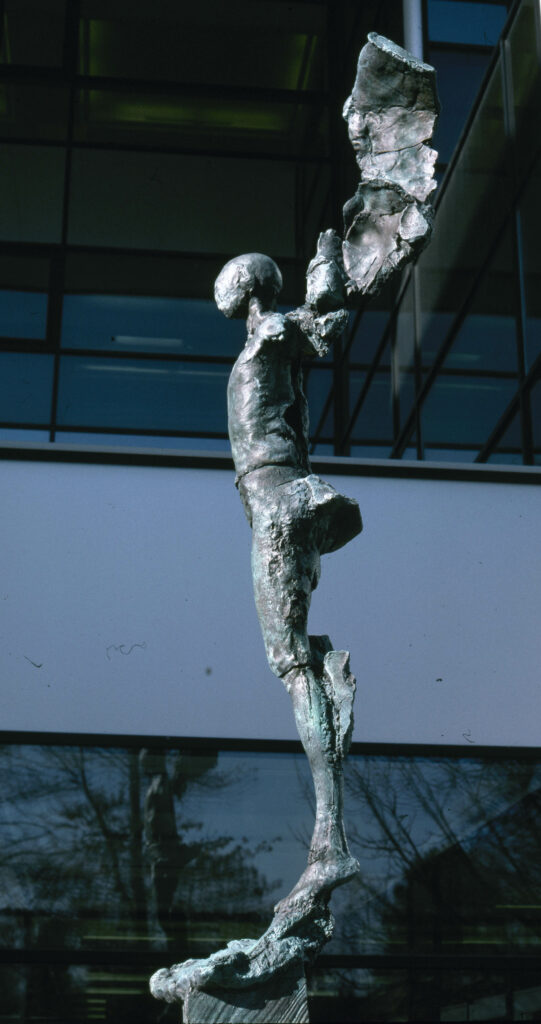
About the Art
The 8-ft tall bronze sculpture’s placement in front of the Parks Library is important to discovering its possible meanings. A library is a repository of human knowledge and this angel standing battered and bruised with only one foot and one wing differs from angels in most western art. The sculpture is precariously balanced as though it might fall creating suspense to the viewer.
Erected in front of Parks Library, it elicited a lot of reactions. The sculpture’s battered and bruised construction generated controversy including requests for the art to be removed. Iowa State University Museums commissioned two poems in reaction to public controversy to Left-Sided Angel. They are presented below.
Neal Bowers of Ames, Iowa penned the following poem, Petition to Remove a Statue in 1990.
Petition to Remove a Statue
Hunk of shrapnel!
Pile of mangled bronze!
We want him down from his one-foot poise.
Victory should be maimed
but beautiful, not banged-up
with barely a leg to stand on.
One wing clipped, the other gone,
how he deforms the whole environment,
warps the air itself with absences.
If sculpture is pure form,
or its pursuit, then this nightmare
comes as close to art
as any freeway accident,
with us out in the bushes
looking for the missing limbs.
We want to make him whole,
in his own perfect image; we want
him far less human than he is;
but since we cannot heal him,
and since he wears our wounds so openly,
by God, we’ll have this unright angel down!
Ann Struthers of Cedar Rapids, Iowa penned the following poem, Left-Sided Angel to Its Critics in 1995. The poem was commissioned by University Museums with inspiration from Stephen De Stabler’s Left-Sided Angel.
Left-Sided Angel to Its Critics
And if I am an angel in decent,
perhaps fallen, in some of its senses,
What did you expect? A neon halo?
Wings with feathers from a dancer’s boa?
These are hard times for the spirit—too much
of everything, too much money, lunches
on the university’s tab, cocktail
patio parties where the whiners impale
olives and gerkins. stab colleagues between
the shoulder blades, slice up their friends,
roast their students over ruby charcoal,
resident novelist, in Mark Twain cool
whites, threatens to put John in his next book—
as a slimy minor character. Look
at yourselves. Who’s unimpared, whole? Surprised,
I watch you watch me through your log clogged eyes.
About the Artist
Stephen De Staebler was born in St. Louis, Missouri in 1933 and was living in California when he passed away in 2011. The precariousness of humanity on earth is a theme that runs through much of his. The following two images are examples of other Stephen De Staebler’s public art installations.
To learn more about his education, teaching, exhibition history, and diverse portfolio, search his website.
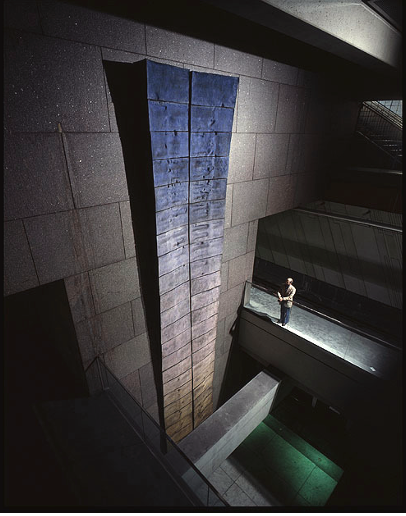
Wall Canyon, 1976/77; fired clay; installed at the Embarcadero Station, Bay Area Regional Transit, San Francisco, CA.
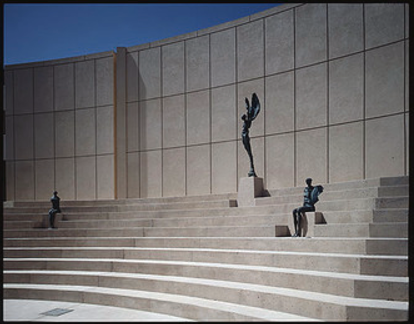
Three Figures, 1992; bronze; installed at the Oakland City Center.
Find both images and more art from the website of Stephen De Staebler.
Relevant History
Angels in culture and history: In theistic religions (one deity), an angel usually serves as the messenger/intermediary for God, acting as a protectorate or guide for mortals. In art, angels are usually depicted with extraordinary beauty, and often include motifs of wings, halos, or a divine light. Stephen de Staebler portrays the angel in a distressed manner in Left-Sided Angel.

Image courtesy of Bing
One of the most celebrated works of Greek art is the Nike of Samothrace, known as Winged Victory. It has been on display at the Louvre in Paris, France since 1884. For additional information, search any of the many websites on the web, including Winged Victory: the Nike of Samothrace – World History Encyclopedia.
Margaret Mead and repaired femur as earliest sign of civilization: A student once asked anthropologist Margaret Mead, “What is the earliest sign of civilization?” The student expected her to say a clay pot, a grinding stone, or maybe a weapon. Margaret Mead thought for a moment then she said “A healed femur.”
A femur is the longest bone in the body, linking the hip to the knee. In societies without the benefit of modern medicine, it takes about six weeks of rest for a fractured femur to heal. A healed femur shows that someone cared for the injured person, did their hunting and gathering, stayed with them, and offered physical protection and human companionship until the injury could mend.
Mead explained that where the law of the jungle – survival of the fittest – rules, no broken femurs are found. The first sign of civilization is compassion, seen in the healed femur.”
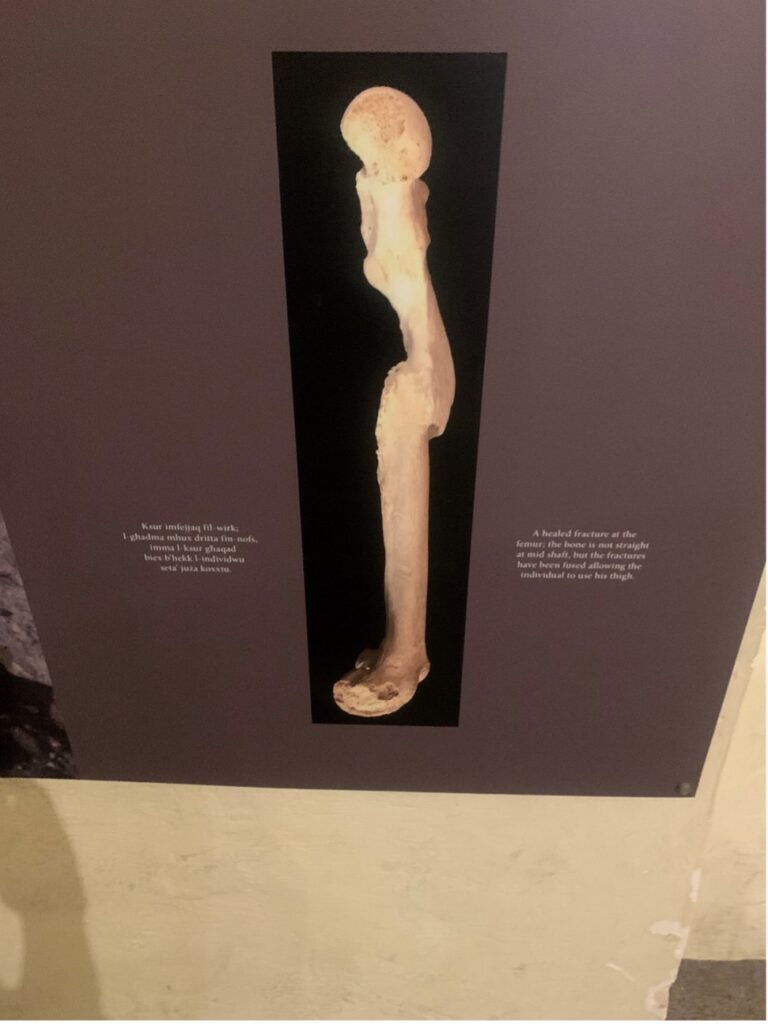
Picture and statement are from the National Museum of Archaeology in Valletta, Malta. The photo was taken by Dr. Klemm while visiting Malta in June 2023.
Learning Guide
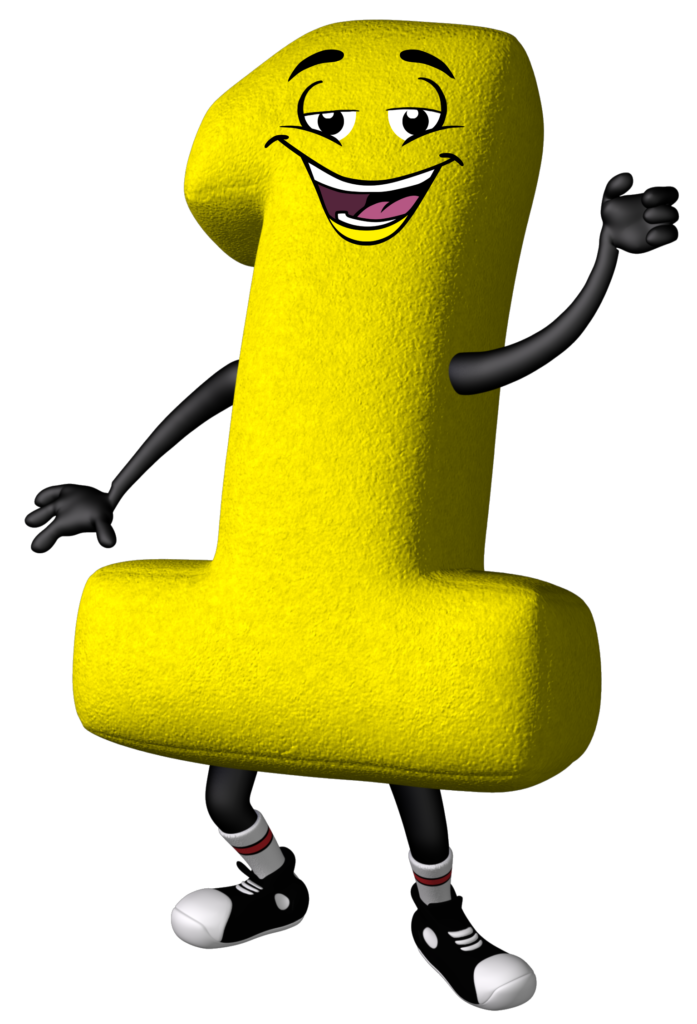
- What do you think the title has to do with the art?
- Why do you think Number Character 1 is speaking about the art?
- How does Number Character 1 differ on the Left-Sided Angel two-page spread with the Number Character 1 on the physical book’s cover? How does the difference relate to Left-Sided Angel?
- What do you think the item Number Character 1 is holding in one hand and how does it relate to Left-Sided Angel?
- How does the shape of the red image with numbers relate to the art?
- How does the hidden blue image relate to the art?
- Why do you think Dr. Klemm added the image of “Winged Victory” as part of history and art relevant to Left-Sided Angel?
- Why do you think Dr. Klemm added the story of Margaret Mead and the femur as part of history relevant to Left-Sided Angel?
- As you discover and interact with Left-Sided Angel, consider the following discussion questions:
- Does it appear to be ready to take off in flight?
- Does it bring a message of hope and reassurance to you and all those who view it?
